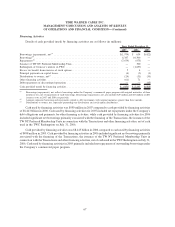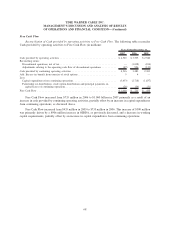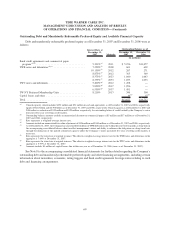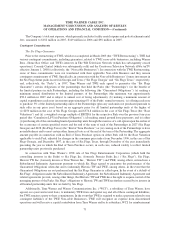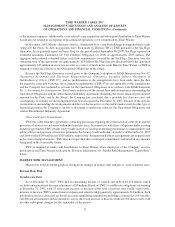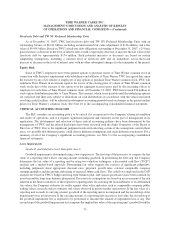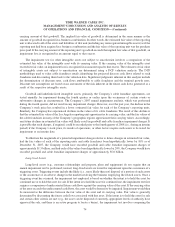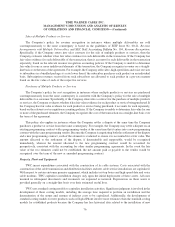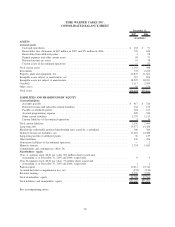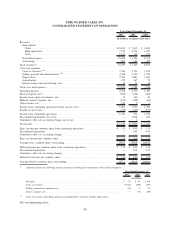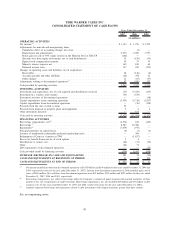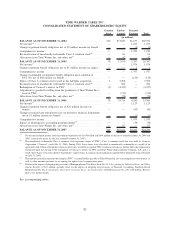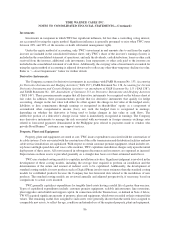Time Warner Cable 2007 Annual Report Download - page 82
Download and view the complete annual report
Please find page 82 of the 2007 Time Warner Cable annual report below. You can navigate through the pages in the report by either clicking on the pages listed below, or by using the keyword search tool below to find specific information within the annual report.products. The standard costing models are reviewed annually and adjusted prospectively, if necessary, based on
comparisons to actual costs incurred.
TWC generally capitalizes expenditures for tangible fixed assets having a useful life of greater than one year.
Types of capitalized expenditures include: customer premise equipment, scalable infrastructure, line extensions,
plant upgrades and rebuilds and support capital. For set-top boxes and modems, useful life is generally 3 to 5 years
and for distribution plant, useful life is up to 16 years. In connection with the Transactions, TW NY acquired
significant amounts of property, plant and equipment, which were recorded at their estimated fair values. The
remaining useful lives assigned to such assets were generally shorter than the useful lives assigned to comparable
new assets, to reflect the age, condition and intended use of the acquired property, plant and equipment.
Programming Agreements
The Company exercises significant judgment in estimating programming expense associated with certain
video programming contracts. The Company’s policy is to record video programming costs based on the
Company’s contractual agreements with its programming vendors, which are generally multi-year agreements
that provide for the Company to make payments to the programming vendors at agreed upon rates, which represent
fair market value, based on the number of subscribers to which the Company provides the service. If a programming
contract expires prior to the parties’ entry into a new agreement, management estimates the programming costs
during the period there is no contract in place. Management considers the previous contractual rates, inflation and
the status of the negotiations in determining its estimates. When the programming contract terms are finalized, an
adjustment to programming expense is recorded, if necessary, to reflect the terms of the new contract. Management
also makes estimates in the recognition of programming expense related to other items, such as the accounting for
free periods and service interruptions, as well as the allocation of consideration exchanged between the parties in
multiple-element transactions. Additionally, judgments are also required by management when the Company
purchases multiple services from the same cable programming vendor. In these scenarios, the total consideration
provided to the programming vendor is required to be allocated to the various services received based upon their
respective fair values. Because multiple services from the same programming vendor are often received over
different contractual periods and often have different contractual rates, the allocation of consideration to the
individual services will have an impact on the timing of the Company’s expense recognition.
Income Taxes
From time to time, the Company engages in transactions in which the tax consequences may be subject to
uncertainty. Examples of such transactions include business acquisitions and dispositions, including those designed
to be tax free, issues related to consideration paid or received, and certain financing transactions. Significant
judgment is required in assessing and estimating the tax consequences of these transactions. The Company prepares
and files tax returns based on interpretation of tax laws and regulations. In the normal course of business, the
Company’s tax returns are subject to examination by various taxing authorities. Such examinations may result in
future tax and interest assessments by these taxing authorities. In determining the Company’s tax provision for
financial reporting purposes, the Company establishes a reserve for uncertain tax positions unless such positions are
determined to be “more likely than not” of being sustained upon examination, based on their technical merits. That
is, for financial reporting purposes, the Company only recognizes tax benefits taken on the tax return that it believes
are “more likely than not” of being sustained. There is considerable judgment involved in determining whether
positions taken on the tax return are “more likely than not” of being sustained.
The Company adjusts its tax reserve estimates periodically because of ongoing examinations by, and
settlements with, the various taxing authorities, as well as changes in tax laws, regulations and interpretations.
The consolidated tax provision of any given year includes adjustments to prior year income tax accruals that are
considered appropriate and any related estimated interest.
77
TIME WARNER CABLE INC.
MANAGEMENT’S DISCUSSION AND ANALYSIS OF RESULTS
OF OPERATIONS AND FINANCIAL CONDITION—(Continued)


